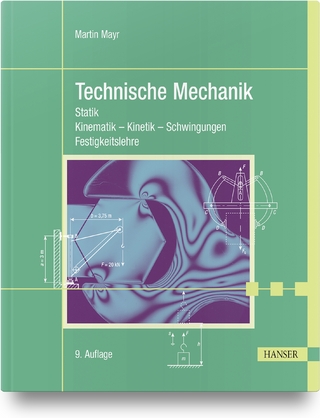
Optical Measurements
Springer Berlin (Verlag)
978-3-642-63079-8 (ISBN)
1 Introduction.- 2 The Schlieren Technique.- 2.1 Introduction.- 2.2 Basic Principle.- 2.3 Optical and Thermodynamic Interrelations.- 2.4 Application of the Schlieren Technique.- 3 Fundamentals of Holography and Interferometry.- 3.1 Abstract.- 3.2 Introduction.- 3.3 Principle of Holography.- 3.4 Simple Holographic Arrangement.- 3.5 Holographic Interferometry.- 3.6 An Interference Method for Simultaneous Heat and Mass Transfer.- 3.7 Comparison with Classical Methods.- 4 Holographic Interferometry.- 4.1 Introduction.- 4.2 Components of a Holographic Interferometer.- 4.3 Evaluation of Interferograms.- 4.4 Examples.- 5 Short Time Holography.- 5.1 Introduction.- 5.2 Elements of holography.- 5.3 Application example: Dispersion characteristics in stirred bubble columns.- 6 Evaluation of holograms by digital image processing.- 6.1 Introduction.- 6.2 A digital image processing system for the evaluation of holographic reconstructions.- 6.3 Image processing.- 6.4 Evaluation of interferograms.- 7 Light Scattering.- 7.1 Introduction.- 7.2 Scattering Processes.- 7.3 Light Scattering Techniques in Heat Transfer.- 7.4 Concluding Remarks.- 8 Laser-Doppler Velocimetry.- 8.1 Introduction.- 8.2 Principles of LDV.- 8.3 Optics.- 8.4 Signal Processing.- 8.5 Seeding Particles.- 8.6 Determination of Characteristic Turbulence-Quantities.- 9 Phase Doppler Anemometry (PDA).- 9.1 Introduction.- 9.2 General considerations for the application of PDA.- 9.3 Principles of PDA.- 9.4 Measurement accuracy.- 9.5 Applications of PDA.- 10 Dynamic Light Scattering.- 10.1 Introduction.- 10.2 Overview.- 10.3 Light Scattering Theory.- 10.4 Experimental Methods.- 10.5 Measurement of Thermal Diffusivity.- 11 Raman Scattering.- 11.1 Introduction.- 11.2 Theoretical Basics of Raman Spectroscopy.- 11.3 Experimentalset-up.- 11.4 Selected Applications.- 11.5 Concluding Remarks.- 12 Laser induced Fluorescence.- 12.1 Introduction.- 12.2 Basic Principles of Laser Induced Fluorescence.- 12.3 Experimental Setup and Procedures.- 12.4 Selected Applications.- 12.5 Concluding Remarks.- 13 Absorption.- 13.1 Introduction.- 13.2 Line spectra.- 13.3 Experimental techniques.- 14 Pyrometry and Thermography.- 14.1 Introduction.- 14.2 Temperature Radiation.- 14.3 Method of Transmission.- 14.4 Radiation Receiver (Detector).- 14.5 Thermal Cameras - Thermography Image Systems.- 14.6 Pyrometers.- 14.7 Error Potential.- 14.8 Appendix.- 15 Tomography.- 15.1 Introduction.- 15.2 Integral Measurement Methods.- 15.3 Mathematical Reconstruction Methods.- 15.4 Implementations.- 16 Particle Image Velocimetry.- 16.1 Introduction.- 16.2 Hardware for the experimental set-up.- 16.3 Evaluation software.- 16.4 Three-dimensional flow.- 16.5 Applications.- Nomenclature.- References.
| Erscheint lt. Verlag | 3.10.2013 |
|---|---|
| Reihe/Serie | Heat and Mass Transfer |
| Zusatzinfo | XVII, 405 p. |
| Verlagsort | Berlin |
| Sprache | englisch |
| Maße | 155 x 235 mm |
| Gewicht | 644 g |
| Themenwelt | Naturwissenschaften ► Physik / Astronomie ► Mechanik |
| Naturwissenschaften ► Physik / Astronomie ► Strömungsmechanik | |
| Naturwissenschaften ► Physik / Astronomie ► Thermodynamik | |
| Technik | |
| Schlagworte | Computer • Diffusion • Dynamics • fluid- and aerodynamics • Fluid Dynamics • heat transfer • Holographie • Holographie / Hologramm • Holography • Laser • Laser-Doppler-Processes • Laser-Doppler-Verfahren • Light Scattering • Measurement • Messverfahren • Optical Measurements • optische • Particle Image Velocimetry • Schliere • Temperature • Thermography • Tomographie • Tomography • Turbulence |
| ISBN-10 | 3-642-63079-0 / 3642630790 |
| ISBN-13 | 978-3-642-63079-8 / 9783642630798 |
| Zustand | Neuware |
| Haben Sie eine Frage zum Produkt? |
aus dem Bereich


